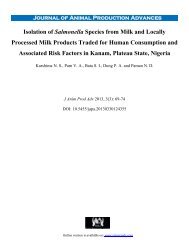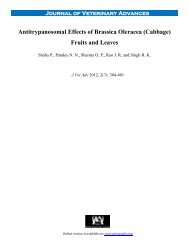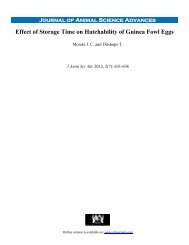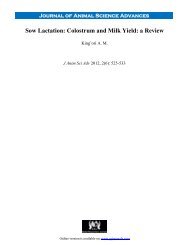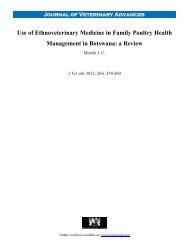PDF Download - Global Researchers Journals
PDF Download - Global Researchers Journals
PDF Download - Global Researchers Journals
Create successful ePaper yourself
Turn your PDF publications into a flip-book with our unique Google optimized e-Paper software.
of human and animal wastes, even by the side of<br />
streets (Aina, 2002, Unpublished B.Sc. project of<br />
Department of Geography, A.B.U. Zaria).<br />
Sample Collection<br />
120 cattle were randomly selected and<br />
ectoparasites specimen were collected from them.<br />
All parts of the body of cattle were carefully<br />
examined. Using hand gloves, the ticks were<br />
removed from the body of the host with all<br />
necessary precautions to avoid damage to the<br />
mouthparts of the ticks and skin of host. Specimens<br />
collected were put in folded white paper (each<br />
sample/ animal) with little space to allow the ticks<br />
have access to air. The specimen containers were<br />
carefully labeled to indicate: breed of cattle, site of<br />
tick location in the body of the animal and sex of<br />
the animal. The samples collected were then<br />
transported to the Veterinary Entomology<br />
Laboratory, ABU, Zaria and directly preserved in<br />
70 % alcohol before examination.<br />
Morphological identification<br />
The live ticks were placed in petri dish<br />
containing 70% alcohol using forceps and the<br />
samples were examined with low power dissecting<br />
microscope (Nikon, made in Japan) and identified<br />
by using the key of morphological characters as<br />
described by Service (1979).<br />
Statistical Analysis<br />
The data collected were tabulated according to<br />
the number of visits to the abattoir. The students ttest<br />
were used to compare the means, correlation<br />
analysis was also used to compare between types of<br />
ticks and the lesions, the sex and breed of cattle;<br />
using the SPSS version 16.<br />
Results and Discussion<br />
Presented in Tables 1, 2, 3, 4 and 5, about 120<br />
heads of cattle were sampled, out of which 66 (55<br />
%) were males and 54 (45 %) females. Among the<br />
breed in the same population, the White Fulani<br />
breed was the most frequent breed with 90 (75 %),<br />
followed by Red Bororo, 20 (16.7 %) and Sokoto<br />
Gudali 10 (8.3 %). The result showed that inguinal<br />
region was the most common predilection site for<br />
83 J. Vet. Adv., 2012, 2(2):81-87<br />
OBADIAH AND SHEKARO<br />
the ticks, with 53 (44. 2 %) and the chest had the<br />
least with 5 (4.2 %).<br />
Table 1: Sex variation in with tick infestation<br />
Sex Frequency Prevalence (%)<br />
Male 66 55.0<br />
Female 54 45.0<br />
Total 120 100<br />
Table 2: Breed associated with tick infestation<br />
Breed Frequency Prevalence (%)<br />
White Fulani 90 75.0<br />
Sokoto Gudali 10 8.3<br />
Red Bororo 20 16.7<br />
Total 120 100<br />
Table 3: Predilection site associated with tick infestation<br />
Predilection site Frequency Prevalence (%)<br />
Inguinal 53 44.2<br />
Chest 5 4.2<br />
General body surface 62 51.7<br />
Total 120 100<br />
Table 4: Types of ticks observed in the animals<br />
Type of tick Frequency Prevalence (%)<br />
Amblyoma sp. 27 22.5<br />
Boophilus sp. 21 17.5<br />
Rhipicephalus sp.<br />
Hyalomma sp.<br />
Others<br />
4<br />
8<br />
60<br />
3.3<br />
6.7<br />
50<br />
Total 120 100<br />
Table 5: Lesions observed associated with tick<br />
infestation<br />
Lesion Frequency Prevalence (%)<br />
Present 19 15.8<br />
Absent 202 84.2<br />
Total 120 100<br />
Four types of ticks were identified:<br />
Amblyomma variegatum, Boophilus decoloratus,<br />
Rhipicephalus sanguineus, and Hyalomma sp. The<br />
frequency of occurrence in the study showed that<br />
Amblyomma variegatum 27 (22. 5 %) was the<br />
commonest ticks observed in cattle in Zaria abattoir<br />
followed by Boophilus decoloratus, 21 (17. 5),<br />
Hyalomma, 8 (6.7 %) and Rhipicephalus<br />
sanguineus 4 (3.3 %). In addition, 19 animals had<br />
skin lesions similar to that described for<br />
Dermatophilos infection while 101 animals had<br />
none. Some of these lesions were associated with<br />
ticks’ infestations, while some were not (Table 4).





